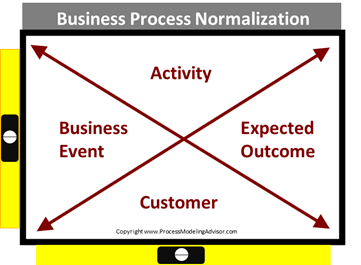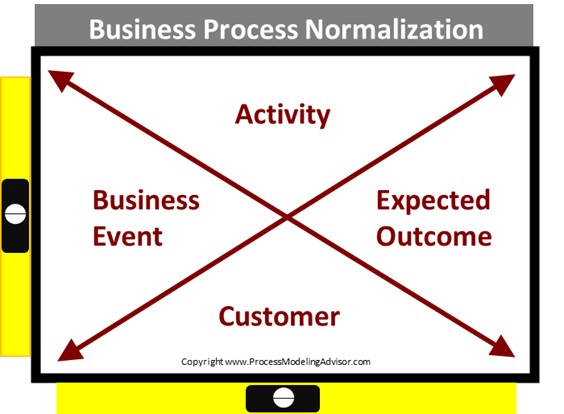By Ed Metera, Program Manager, Instructor, Book Author and Founder of ProcessModelingAdvisor.com

Business Process Normalization[1] is an analysis technique that leads to sound, modern business process and workflow structures.

Business analysts, process analysts, systems analysts, and process owners use Business Process Normalization to more effectively elicit and perceive, unequivocally define, and model sound, modern business process structures, and workflow configurations. Proficiency with this analysis technique benefits their process management, digital transformation, and regulatory compliance projects.
What is a Business Process Anyways?
For decades, business analysts, process analysts, and their projects’ stakeholders have tried to define business processes according to various characteristics. Business processes have been said to transform inputs into outputs. They can be decomposed into smaller parts. They start. They “flow”. They end. They have customers. They can cross organizational boundaries. They can be automated. They can be manual. They are measurable. While all those statements may be true, none of them are sufficient enough to elicit, perceive, and unequivocally define and produce high-quality business process structures.
There will be about as many points of view and opinions about what any business process is as there are stakeholders in that process, at least at the start of the process analysis. As always, business analysts and process analysts need to be able to consistently perceive processes and facilitate the journey of business process elicitation, definition, and modeling, with their stakeholders. However, the pace and the technologies of modern, digital transformation, low-code and no-code projects demand that business process and workflow elicitation, and definition be done in an efficient, competent way, instead of ad-hoc questioning and trial and error.
Times have changed
Traditional, procedural notions and flowcharting notations have become archaic. They were invented in the days of procedural language programming – in the last millennium. Those notions don’t always work in today’s business and technical environments. Today’s distributed business structures (has anyone been working remotely recently?), technologies like the Internet of Things (IoT) and Edge, mobility, and cloud computing services have radically modernized the business process landscape. Today, a high-quality business process structure is one that has been conceived, structured and can be readily configured as a modern, collaborating network of event-driven, outcome-oriented services, not just as a sequential procedure.
The Universal Business Process Definition
Let’s look at housing. Any house, no matter its scale, degree of abstraction, location, building materials, and all its unique details, etc. must have a foundation, walls, and a roof to be a house. If it’s missing any of those, it is not acceptable as a house. And for obvious productivity and quality reasons, those basic structural elements are established first, before it is practical to invest time and money in a home’s other architectural, engineering or construction refinements.
The same is true for business processes and workflow structures. Any business process must have a sound, cohesive structure of basic elements to be considered a sound business process. Its basic structural elements should be elicited and consensus reached, before pursuing all of a process’s possible details and refinements. Even after all desired process refinements have been applied, the process will still have its defining structural elements. This holds true for any process structure or model at any degree of abstraction (ie. conceptual, logical, or configuration), a process’ scale, or the unique details about a business process or workflow.
So, what are the basic business process-defining elements? Paraphrasing the Universal Business Process Definition[2], any business process (or business activity for that matter) is 1) a repeatable collection of work activities, 2) initiated in response to a business event that, 3) achieves an expected outcome, 4) for a customer of that process. These four common-sense rules define all processes, workflows, and activities regardless of a process’ or activity’s scale, the process model’s degree of abstraction, the overarching project methodology, the modeling participants, and the organizations and the technologies that will implement the process or workflow.
Uses of the Business Universal Business Process Definition
Business analysts and process analysts use the Universal Business Process Definition’s four common-sense rules throughout their business process modeling journey and they work out and arrive at high-quality, robust, predictable, and operational business process structures. The Universal Business Process Definition framework helps them to elicit, perceive, normalize and unequivocally define any business process. They use it to guide their elicitation agendas with business stakeholders. They use it to frame their observations of business processes. They use it to normalize what they and their stakeholders have named as candidate processes. They use it to resolve ambiguity among stakeholders and to organize business activities into the optimal, modern business process and workflow structures. This is akin to understanding and applying the Business Normal Forms[3], long used by business analysts and systems analysts to work out and optimally organize data attributes into entities and to produce high-quality relational data structures.
The resulting business process structures are high-quality structures because they have been elicited, perceived, and defined by asking and answering the right questions. They can be implemented equally well as traditional sequential procedures or as today’s, distributed business structures and networked technical (like cloud services) architectures. As event-driven, outcome-oriented business process structures, they are also consistent with modern networked, collaborative business relationships and cloud technologies.
Business Process Normalization
Business Process Normalization is the analysis technique of testing the contextual meaning of a candidate business process according to the Universal Business Process Definition’s four rules.
A business analyst or process analyst need not ask a lot of questions to normalize a business process or workflow. They only need to ask a few focused questions (four in fact) and doggedly pursue and gain consensus to the four, sometimes-elusive, answers. The assumed basic structure of a business process will either be affirmed or restructured by the answers to the normalization questions. If any of the four tests have not yet been satisfactorily answered, then the analyst will need to elicit more information (documentation reviews, interviews, workshops, mining) to satisfactorily answer the four process-defining tests.
Once all four tests have been sufficiently answered, the process has been normalized. Ambiguities have been resolved. A sound, fundamental business process or workflow structure has been understood. The answers to the four tests can then be used to write a contextually accurate, unequivocal, plain-language process definition. No two processes will likely have the same definition within the same domain of analysis. The normalized process’s defining structure will be the foundation of a contextually accurate, high-quality business process model, configured business procedure, or automated workflow.
Benefits of Business Process Normalization
The benefits of using the four-part Universal Business Process Definition’s rules and the Business Process Normalization technique are that they are relevant for today, it is efficient, it boosts contextual quality, it minimizes redundant and non-value-adding activities, it aids in well-written process descriptions and it improves the potential for reusable business services.
Learn more …
You can establish or improve your business process modeling competence and learn the Business Process Normalization technique, by reading:
- Universal Process Modeling Procedure – The Practical Guide to High-Quality Business Process Models Using BPMN, (Metera, 2017). This how-to guide’s topics include the step-by-step Universal Business Process Modeling Procedure, razor-sharp elicitation agendas, the Universal Business Process Definition, Business Process Normalization, basic and refined process modeling patterns using BPMN, and Universal Business Process Model Quality Checklists.
- www.ProcessModelingAdvisor.com. The site’s purpose is to help you establish or improve your business process modeling competence. It includes articles, process model examples using BPMN, checklists, and access to out-of-the-box IIBA-endorsed and bespoke business process modeling training.
Copyright 2022, Edmund Metera
_____________________________
Author: Edmund Metera, Founder: Process Modeling Advisor
Edmund Metera has taught and mentored project managers and business analysts in best practices for professional organizations such as PMI, IIBA, and CMMI. Ed teaches IIBA-endorsed business analysis courses and is an advisor to the Northern Alberta Institute of Technology’s Corporate and International Training department’s Business Analyst, Process Analyst, and other certificate programs. He is the author of the book: Universal Process Modeling Procedure: The Practical Guide to High-Quality Business Process Models Using BPMN (Amazon) and the founder of www.ProcessModelingAdvisor.com.
[1] Universal Process Modeling Procedure – The Practical Guide to High-Quality Business Process Models Using BPMN (Metera)
[2] Universal Process Modeling Procedure – The Practical Guide to High-Quality Business Process Models Using BPMN (Metera)
[3] The Data Modeling Handbook (Reingruber and Gregory)


